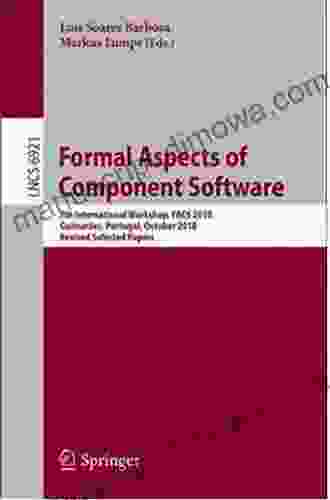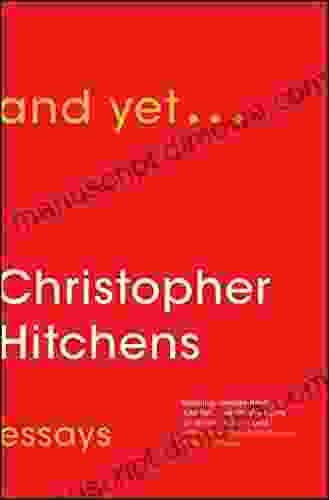Formal Aspects of Component Software: A Comprehensive Guide to Building Reliable and Reusable Software Systems

Component-based software engineering (CBSE) is a software development paradigm that promotes the construction of software systems from reusable components. CBSE offers several advantages over traditional development approaches, including increased productivity, reduced development time, and improved software quality. However, CBSE also introduces new challenges, such as the need to ensure that components are reliable and reusable.
4.6 out of 5
| Language | : | English |
| File size | : | 37238 KB |
| Text-to-Speech | : | Enabled |
| Screen Reader | : | Supported |
| Enhanced typesetting | : | Enabled |
| Print length | : | 354 pages |
| Paperback | : | 24 pages |
| Item Weight | : | 3.68 ounces |
| Dimensions | : | 8 x 0.06 x 10 inches |
Formal methods provide a powerful tool for addressing the challenges of CBSE. Formal methods are mathematical techniques that can be used to specify, analyze, and verify software systems. By using formal methods, we can gain a deeper understanding of the behavior of software systems and identify potential problems early in the development process.
Formal Specification of Component Software
The first step in developing component software is to create a formal specification of the system. A formal specification is a mathematical model of the system that describes its behavior in a precise and unambiguous way. Formal specifications can be used to verify that the system meets its requirements and to identify potential design flaws.
There are a number of different formal specification languages that can be used to specify component software. Some of the most popular languages include:
- Z
- B
- VDM
- Event-B
- Alloy
Formal Analysis of Component Software
Once a formal specification has been created, it can be used to analyze the system. Formal analysis techniques can be used to verify that the system meets its requirements and to identify potential design flaws. There are a number of different formal analysis techniques that can be used to analyze component software, including:
- Model checking
- Theorem proving
- Abstract interpretation
- Symbolic execution
Formal Verification of Component Software
Formal verification is the process of proving that a software system meets its requirements. Formal verification techniques can be used to guarantee that the system will behave as expected, even in the presence of errors. There are a number of different formal verification techniques that can be used to verify component software, including:
- Model checking
- Theorem proving
- Deductive verification
Case Studies
This book includes a number of case studies that illustrate the use of formal methods in the development of component software. These case studies cover a wide range of topics, including:
- The development of a safety-critical medical device
- The development of a distributed e-commerce system
- The development of a real-time embedded system
Formal methods provide a powerful tool for developing reliable and reusable component software. By using formal methods, we can gain a deeper understanding of the behavior of software systems and identify potential problems early in the development process. This book provides a comprehensive guide to the formal aspects of component software, covering all aspects of the development process from specification to verification.
4.6 out of 5
| Language | : | English |
| File size | : | 37238 KB |
| Text-to-Speech | : | Enabled |
| Screen Reader | : | Supported |
| Enhanced typesetting | : | Enabled |
| Print length | : | 354 pages |
| Paperback | : | 24 pages |
| Item Weight | : | 3.68 ounces |
| Dimensions | : | 8 x 0.06 x 10 inches |
Do you want to contribute by writing guest posts on this blog?
Please contact us and send us a resume of previous articles that you have written.
 Book
Book Novel
Novel Page
Page Chapter
Chapter Text
Text Story
Story Genre
Genre Reader
Reader Library
Library Paperback
Paperback E-book
E-book Magazine
Magazine Newspaper
Newspaper Paragraph
Paragraph Sentence
Sentence Bookmark
Bookmark Shelf
Shelf Glossary
Glossary Bibliography
Bibliography Foreword
Foreword Preface
Preface Synopsis
Synopsis Annotation
Annotation Footnote
Footnote Manuscript
Manuscript Scroll
Scroll Codex
Codex Tome
Tome Bestseller
Bestseller Classics
Classics Library card
Library card Narrative
Narrative Biography
Biography Autobiography
Autobiography Memoir
Memoir Reference
Reference Encyclopedia
Encyclopedia Christine O Toole
Christine O Toole Karen Cardno
Karen Cardno The Navigators
The Navigators Chris Binns
Chris Binns Chris Snyder
Chris Snyder Christian Kuehn
Christian Kuehn Tanya Agathocleous
Tanya Agathocleous Leigh Red
Leigh Red Charley Hester
Charley Hester Shannon Kubiak Primicerio
Shannon Kubiak Primicerio Charlotte Nicole Davis
Charlotte Nicole Davis Chris Nwani
Chris Nwani Christopher Danielson
Christopher Danielson Chris Taylor
Chris Taylor Christian Jannasch
Christian Jannasch Charles Sledge
Charles Sledge Christopher R W Dietrich
Christopher R W Dietrich Chris Townsend
Chris Townsend Chris Serb
Chris Serb Imriyas Kamardeen
Imriyas Kamardeen
Light bulbAdvertise smarter! Our strategic ad space ensures maximum exposure. Reserve your spot today!

 Roger TurnerGridiron Greats: Uncover the Revolutionary Legacy of "Two Men: The Patriots...
Roger TurnerGridiron Greats: Uncover the Revolutionary Legacy of "Two Men: The Patriots... William FaulknerFollow ·11.8k
William FaulknerFollow ·11.8k Derek CookFollow ·2.9k
Derek CookFollow ·2.9k Darrell PowellFollow ·4.1k
Darrell PowellFollow ·4.1k Eric NelsonFollow ·14.9k
Eric NelsonFollow ·14.9k Hayden MitchellFollow ·11.7k
Hayden MitchellFollow ·11.7k George R.R. MartinFollow ·13.1k
George R.R. MartinFollow ·13.1k Gordon CoxFollow ·4.8k
Gordon CoxFollow ·4.8k Cason CoxFollow ·7.8k
Cason CoxFollow ·7.8k

 Frank Mitchell
Frank MitchellStep Onto the Dance Floor of Spanish Fluency with...
Are you ready to take a...

 Jarrett Blair
Jarrett BlairEscape into the Enchanting Realm of "The British Empire...
Embark on an Extraordinary Literary Journey...

 Gregory Woods
Gregory WoodsHitler Olympics: The 1936 Berlin Olympic Games
The 1936 Berlin Olympic Games...

 Philip Bell
Philip BellThe British Empire of Magic and the Dark Knights King: An...
In the tapestry of literary...

 Jacob Hayes
Jacob HayesPerilous Journey of Danger and Mayhem: A Thrilling...
In the untamed wilderness,...
4.6 out of 5
| Language | : | English |
| File size | : | 37238 KB |
| Text-to-Speech | : | Enabled |
| Screen Reader | : | Supported |
| Enhanced typesetting | : | Enabled |
| Print length | : | 354 pages |
| Paperback | : | 24 pages |
| Item Weight | : | 3.68 ounces |
| Dimensions | : | 8 x 0.06 x 10 inches |












